Effective Cross-Cultural Communication Strategies: Overcoming Barriers
VerifiedAdded on 2020/02/24
|10
|2263
|323
Essay
AI Summary
This essay delves into the multifaceted challenges of cross-cultural communication, particularly in the context of expanding global businesses. It examines the impact of cultural differences, focusing on the contrast between individualistic and collectivist cultures, using the American culture as an example. The paper explores various communication barriers, including language differences, nonverbal cues, and the influence of high and low-context cultures. It discusses the importance of understanding Hofstede's cultural dimensions model and its implications for effective communication. The essay also addresses practical aspects such as do's and don'ts for interacting with people from different cultures and the role of online communication. Ultimately, it emphasizes the need for cultural sensitivity and the adoption of strategies to overcome communication barriers to foster a better working environment and achieve cultural balance in a globalized world.

Running head: COMMUNICATION
Communication
Name of the Student
Name of the University
Author Note
Communication
Name of the Student
Name of the University
Author Note
Paraphrase This Document
Need a fresh take? Get an instant paraphrase of this document with our AI Paraphraser
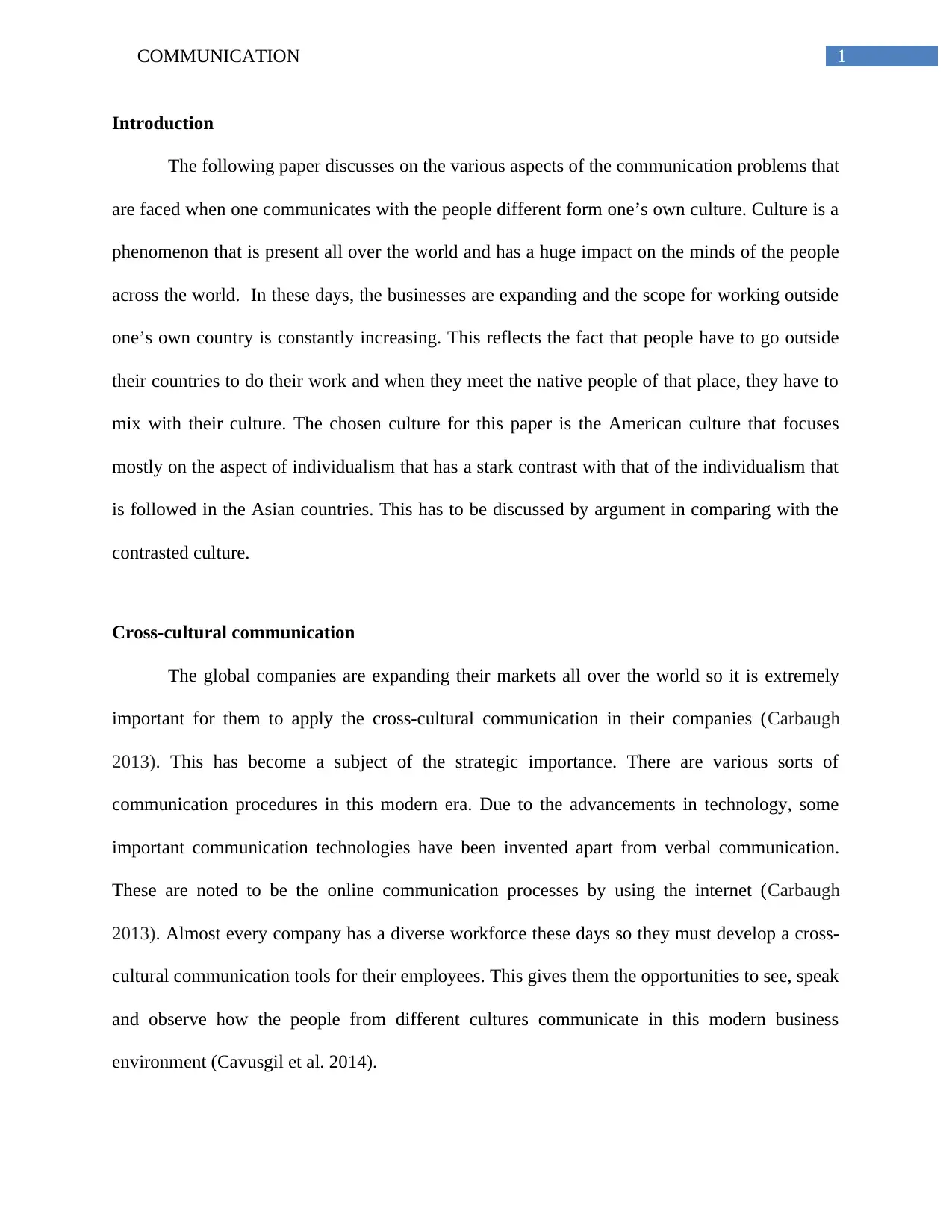
1COMMUNICATION
Introduction
The following paper discusses on the various aspects of the communication problems that
are faced when one communicates with the people different form one’s own culture. Culture is a
phenomenon that is present all over the world and has a huge impact on the minds of the people
across the world. In these days, the businesses are expanding and the scope for working outside
one’s own country is constantly increasing. This reflects the fact that people have to go outside
their countries to do their work and when they meet the native people of that place, they have to
mix with their culture. The chosen culture for this paper is the American culture that focuses
mostly on the aspect of individualism that has a stark contrast with that of the individualism that
is followed in the Asian countries. This has to be discussed by argument in comparing with the
contrasted culture.
Cross-cultural communication
The global companies are expanding their markets all over the world so it is extremely
important for them to apply the cross-cultural communication in their companies (Carbaugh
2013). This has become a subject of the strategic importance. There are various sorts of
communication procedures in this modern era. Due to the advancements in technology, some
important communication technologies have been invented apart from verbal communication.
These are noted to be the online communication processes by using the internet (Carbaugh
2013). Almost every company has a diverse workforce these days so they must develop a cross-
cultural communication tools for their employees. This gives them the opportunities to see, speak
and observe how the people from different cultures communicate in this modern business
environment (Cavusgil et al. 2014).
Introduction
The following paper discusses on the various aspects of the communication problems that
are faced when one communicates with the people different form one’s own culture. Culture is a
phenomenon that is present all over the world and has a huge impact on the minds of the people
across the world. In these days, the businesses are expanding and the scope for working outside
one’s own country is constantly increasing. This reflects the fact that people have to go outside
their countries to do their work and when they meet the native people of that place, they have to
mix with their culture. The chosen culture for this paper is the American culture that focuses
mostly on the aspect of individualism that has a stark contrast with that of the individualism that
is followed in the Asian countries. This has to be discussed by argument in comparing with the
contrasted culture.
Cross-cultural communication
The global companies are expanding their markets all over the world so it is extremely
important for them to apply the cross-cultural communication in their companies (Carbaugh
2013). This has become a subject of the strategic importance. There are various sorts of
communication procedures in this modern era. Due to the advancements in technology, some
important communication technologies have been invented apart from verbal communication.
These are noted to be the online communication processes by using the internet (Carbaugh
2013). Almost every company has a diverse workforce these days so they must develop a cross-
cultural communication tools for their employees. This gives them the opportunities to see, speak
and observe how the people from different cultures communicate in this modern business
environment (Cavusgil et al. 2014).
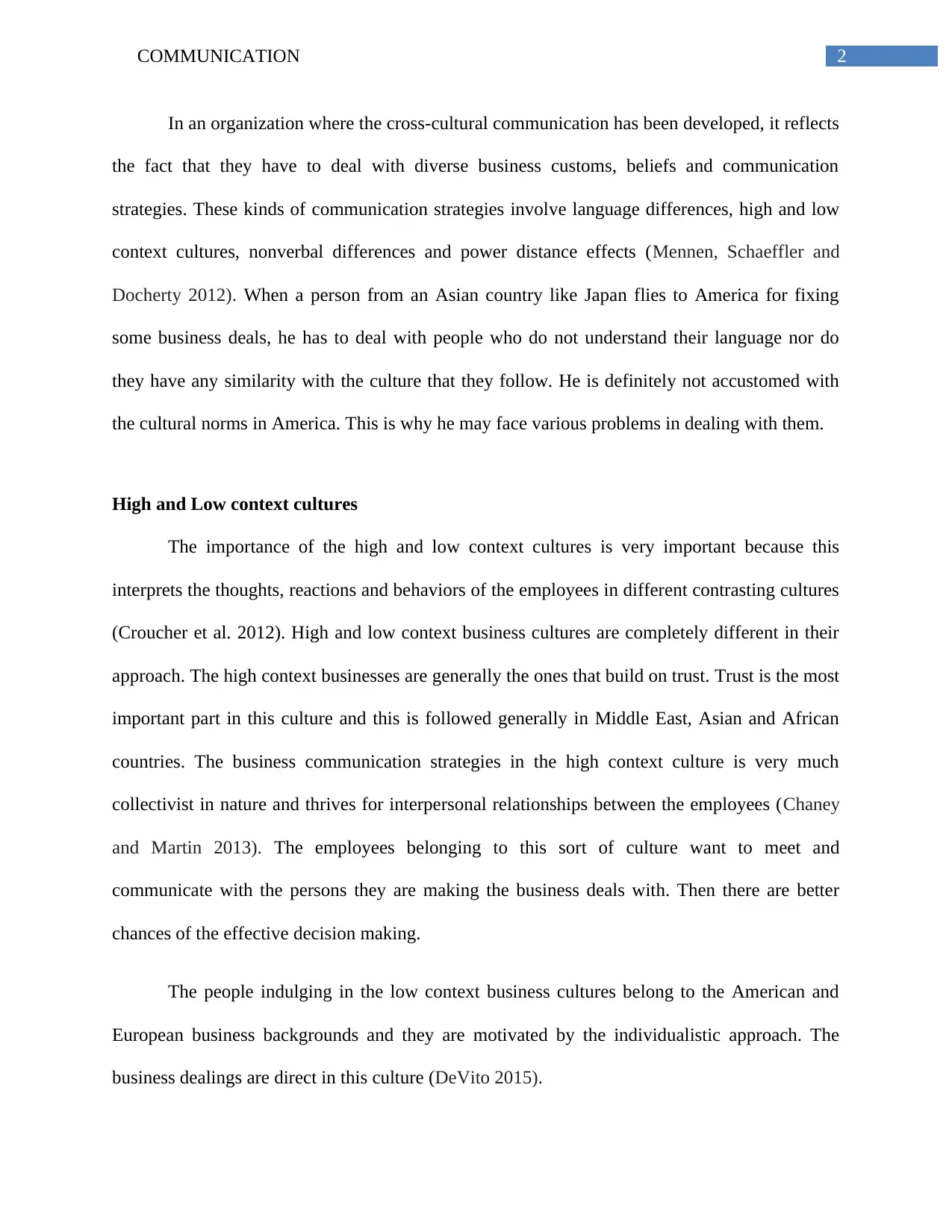
2COMMUNICATION
In an organization where the cross-cultural communication has been developed, it reflects
the fact that they have to deal with diverse business customs, beliefs and communication
strategies. These kinds of communication strategies involve language differences, high and low
context cultures, nonverbal differences and power distance effects (Mennen, Schaeffler and
Docherty 2012). When a person from an Asian country like Japan flies to America for fixing
some business deals, he has to deal with people who do not understand their language nor do
they have any similarity with the culture that they follow. He is definitely not accustomed with
the cultural norms in America. This is why he may face various problems in dealing with them.
High and Low context cultures
The importance of the high and low context cultures is very important because this
interprets the thoughts, reactions and behaviors of the employees in different contrasting cultures
(Croucher et al. 2012). High and low context business cultures are completely different in their
approach. The high context businesses are generally the ones that build on trust. Trust is the most
important part in this culture and this is followed generally in Middle East, Asian and African
countries. The business communication strategies in the high context culture is very much
collectivist in nature and thrives for interpersonal relationships between the employees (Chaney
and Martin 2013). The employees belonging to this sort of culture want to meet and
communicate with the persons they are making the business deals with. Then there are better
chances of the effective decision making.
The people indulging in the low context business cultures belong to the American and
European business backgrounds and they are motivated by the individualistic approach. The
business dealings are direct in this culture (DeVito 2015).
In an organization where the cross-cultural communication has been developed, it reflects
the fact that they have to deal with diverse business customs, beliefs and communication
strategies. These kinds of communication strategies involve language differences, high and low
context cultures, nonverbal differences and power distance effects (Mennen, Schaeffler and
Docherty 2012). When a person from an Asian country like Japan flies to America for fixing
some business deals, he has to deal with people who do not understand their language nor do
they have any similarity with the culture that they follow. He is definitely not accustomed with
the cultural norms in America. This is why he may face various problems in dealing with them.
High and Low context cultures
The importance of the high and low context cultures is very important because this
interprets the thoughts, reactions and behaviors of the employees in different contrasting cultures
(Croucher et al. 2012). High and low context business cultures are completely different in their
approach. The high context businesses are generally the ones that build on trust. Trust is the most
important part in this culture and this is followed generally in Middle East, Asian and African
countries. The business communication strategies in the high context culture is very much
collectivist in nature and thrives for interpersonal relationships between the employees (Chaney
and Martin 2013). The employees belonging to this sort of culture want to meet and
communicate with the persons they are making the business deals with. Then there are better
chances of the effective decision making.
The people indulging in the low context business cultures belong to the American and
European business backgrounds and they are motivated by the individualistic approach. The
business dealings are direct in this culture (DeVito 2015).
⊘ This is a preview!⊘
Do you want full access?
Subscribe today to unlock all pages.

Trusted by 1+ million students worldwide
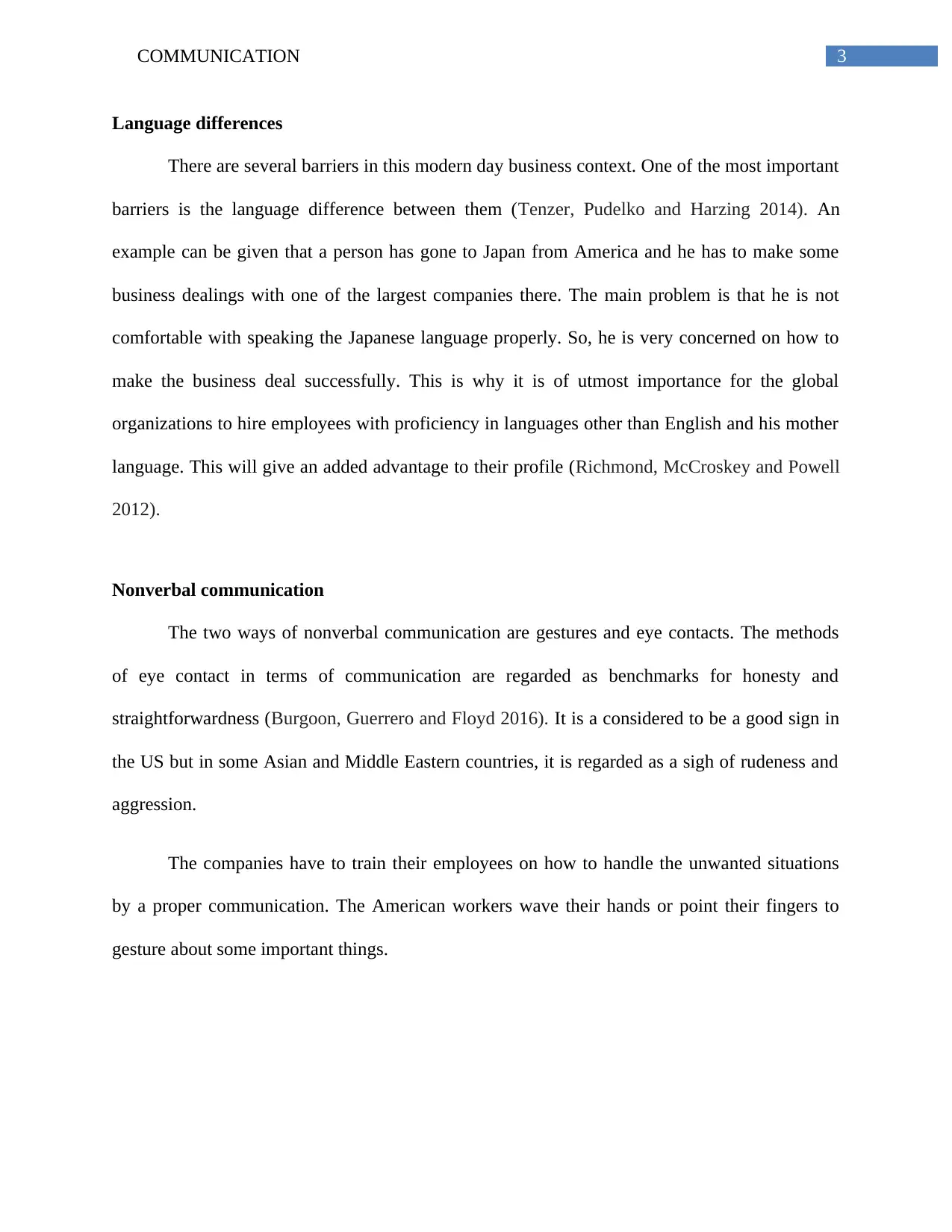
3COMMUNICATION
Language differences
There are several barriers in this modern day business context. One of the most important
barriers is the language difference between them (Tenzer, Pudelko and Harzing 2014). An
example can be given that a person has gone to Japan from America and he has to make some
business dealings with one of the largest companies there. The main problem is that he is not
comfortable with speaking the Japanese language properly. So, he is very concerned on how to
make the business deal successfully. This is why it is of utmost importance for the global
organizations to hire employees with proficiency in languages other than English and his mother
language. This will give an added advantage to their profile (Richmond, McCroskey and Powell
2012).
Nonverbal communication
The two ways of nonverbal communication are gestures and eye contacts. The methods
of eye contact in terms of communication are regarded as benchmarks for honesty and
straightforwardness (Burgoon, Guerrero and Floyd 2016). It is a considered to be a good sign in
the US but in some Asian and Middle Eastern countries, it is regarded as a sigh of rudeness and
aggression.
The companies have to train their employees on how to handle the unwanted situations
by a proper communication. The American workers wave their hands or point their fingers to
gesture about some important things.
Language differences
There are several barriers in this modern day business context. One of the most important
barriers is the language difference between them (Tenzer, Pudelko and Harzing 2014). An
example can be given that a person has gone to Japan from America and he has to make some
business dealings with one of the largest companies there. The main problem is that he is not
comfortable with speaking the Japanese language properly. So, he is very concerned on how to
make the business deal successfully. This is why it is of utmost importance for the global
organizations to hire employees with proficiency in languages other than English and his mother
language. This will give an added advantage to their profile (Richmond, McCroskey and Powell
2012).
Nonverbal communication
The two ways of nonverbal communication are gestures and eye contacts. The methods
of eye contact in terms of communication are regarded as benchmarks for honesty and
straightforwardness (Burgoon, Guerrero and Floyd 2016). It is a considered to be a good sign in
the US but in some Asian and Middle Eastern countries, it is regarded as a sigh of rudeness and
aggression.
The companies have to train their employees on how to handle the unwanted situations
by a proper communication. The American workers wave their hands or point their fingers to
gesture about some important things.
Paraphrase This Document
Need a fresh take? Get an instant paraphrase of this document with our AI Paraphraser
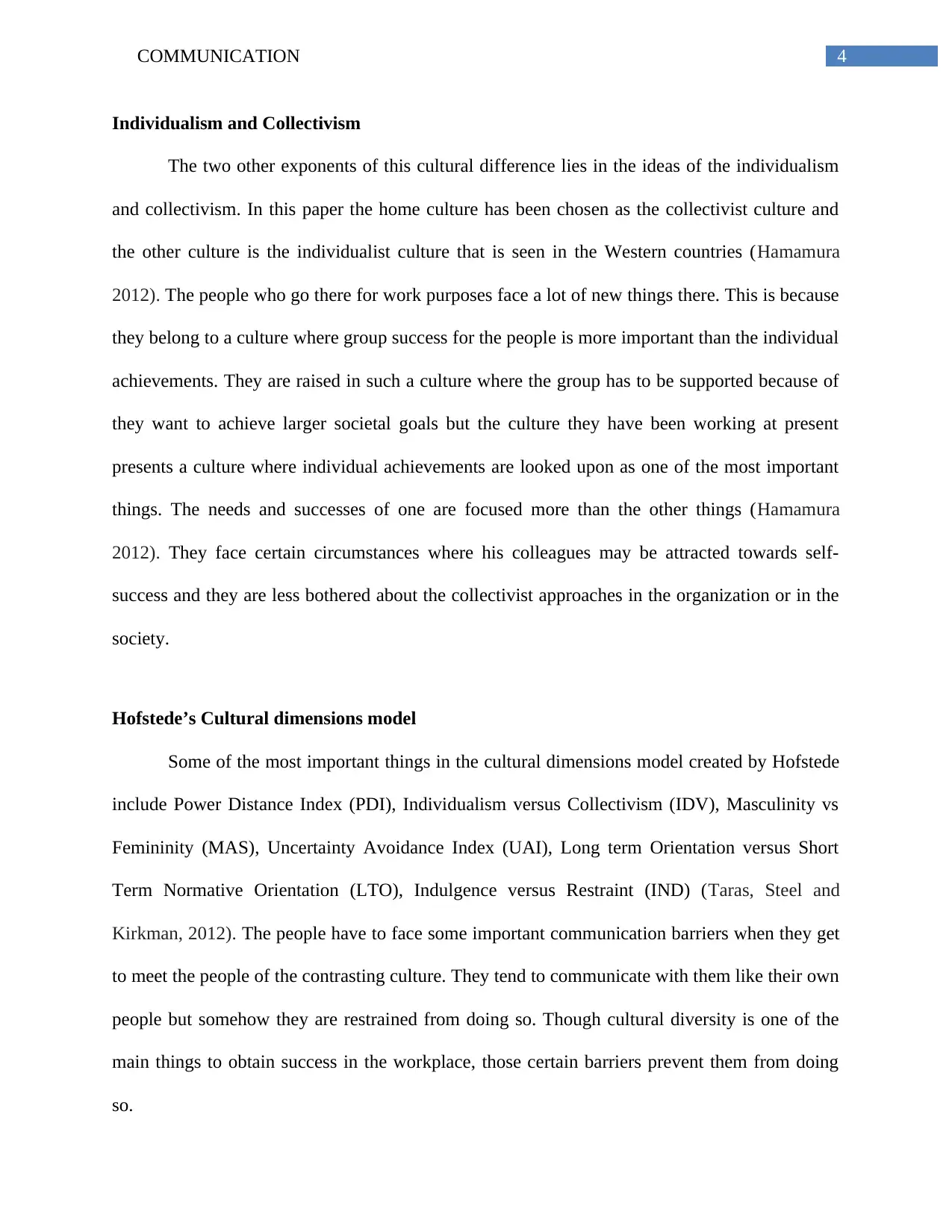
4COMMUNICATION
Individualism and Collectivism
The two other exponents of this cultural difference lies in the ideas of the individualism
and collectivism. In this paper the home culture has been chosen as the collectivist culture and
the other culture is the individualist culture that is seen in the Western countries (Hamamura
2012). The people who go there for work purposes face a lot of new things there. This is because
they belong to a culture where group success for the people is more important than the individual
achievements. They are raised in such a culture where the group has to be supported because of
they want to achieve larger societal goals but the culture they have been working at present
presents a culture where individual achievements are looked upon as one of the most important
things. The needs and successes of one are focused more than the other things (Hamamura
2012). They face certain circumstances where his colleagues may be attracted towards self-
success and they are less bothered about the collectivist approaches in the organization or in the
society.
Hofstede’s Cultural dimensions model
Some of the most important things in the cultural dimensions model created by Hofstede
include Power Distance Index (PDI), Individualism versus Collectivism (IDV), Masculinity vs
Femininity (MAS), Uncertainty Avoidance Index (UAI), Long term Orientation versus Short
Term Normative Orientation (LTO), Indulgence versus Restraint (IND) (Taras, Steel and
Kirkman, 2012). The people have to face some important communication barriers when they get
to meet the people of the contrasting culture. They tend to communicate with them like their own
people but somehow they are restrained from doing so. Though cultural diversity is one of the
main things to obtain success in the workplace, those certain barriers prevent them from doing
so.
Individualism and Collectivism
The two other exponents of this cultural difference lies in the ideas of the individualism
and collectivism. In this paper the home culture has been chosen as the collectivist culture and
the other culture is the individualist culture that is seen in the Western countries (Hamamura
2012). The people who go there for work purposes face a lot of new things there. This is because
they belong to a culture where group success for the people is more important than the individual
achievements. They are raised in such a culture where the group has to be supported because of
they want to achieve larger societal goals but the culture they have been working at present
presents a culture where individual achievements are looked upon as one of the most important
things. The needs and successes of one are focused more than the other things (Hamamura
2012). They face certain circumstances where his colleagues may be attracted towards self-
success and they are less bothered about the collectivist approaches in the organization or in the
society.
Hofstede’s Cultural dimensions model
Some of the most important things in the cultural dimensions model created by Hofstede
include Power Distance Index (PDI), Individualism versus Collectivism (IDV), Masculinity vs
Femininity (MAS), Uncertainty Avoidance Index (UAI), Long term Orientation versus Short
Term Normative Orientation (LTO), Indulgence versus Restraint (IND) (Taras, Steel and
Kirkman, 2012). The people have to face some important communication barriers when they get
to meet the people of the contrasting culture. They tend to communicate with them like their own
people but somehow they are restrained from doing so. Though cultural diversity is one of the
main things to obtain success in the workplace, those certain barriers prevent them from doing
so.

5COMMUNICATION
Language barriers
It is a common trait that the people are becoming more indulgent in going to the other
countries that may follow the complete contrasting cultures than that of them. This is also a
factor that if the people go to the Western countries, they face this language problem most of the
times (McCarthy et al. 2013). Most of the people from the Asian community have English as
their second language but in their workplaces, English is the first language in most of the cases.
This is also to say that the employees who may belong to the same country but in another region,
use different words to communicate with the same meaning. This is very important in the case of
the organizations and the HR managers have to make remedies for solving this problem
(McCarthy et al. 2013).
Gender barriers
In the professional areas, difference in gender is another important thing that has to be
dealt with strict execution (DuBrin 2013). These things happen when the amount of the male and
female employees in an organization is disproportionate. As the individualist culture is all about
achieving the self-success, the female employees want to dominate the male employees and the
vice versa. This communication gap restrains the organizational success (DuBrin 2013)
Do’s and Dont’s
When the guests from the individualist culture try to assimilate into the contrasting
collectivist culture, the host persons must try to listen and respond to their queries.
Do Don’t
The host people should always listen to what the
guests have to say with attention. They should try
They should never just listen to the guests in a
Language barriers
It is a common trait that the people are becoming more indulgent in going to the other
countries that may follow the complete contrasting cultures than that of them. This is also a
factor that if the people go to the Western countries, they face this language problem most of the
times (McCarthy et al. 2013). Most of the people from the Asian community have English as
their second language but in their workplaces, English is the first language in most of the cases.
This is also to say that the employees who may belong to the same country but in another region,
use different words to communicate with the same meaning. This is very important in the case of
the organizations and the HR managers have to make remedies for solving this problem
(McCarthy et al. 2013).
Gender barriers
In the professional areas, difference in gender is another important thing that has to be
dealt with strict execution (DuBrin 2013). These things happen when the amount of the male and
female employees in an organization is disproportionate. As the individualist culture is all about
achieving the self-success, the female employees want to dominate the male employees and the
vice versa. This communication gap restrains the organizational success (DuBrin 2013)
Do’s and Dont’s
When the guests from the individualist culture try to assimilate into the contrasting
collectivist culture, the host persons must try to listen and respond to their queries.
Do Don’t
The host people should always listen to what the
guests have to say with attention. They should try
They should never just listen to the guests in a
⊘ This is a preview!⊘
Do you want full access?
Subscribe today to unlock all pages.

Trusted by 1+ million students worldwide
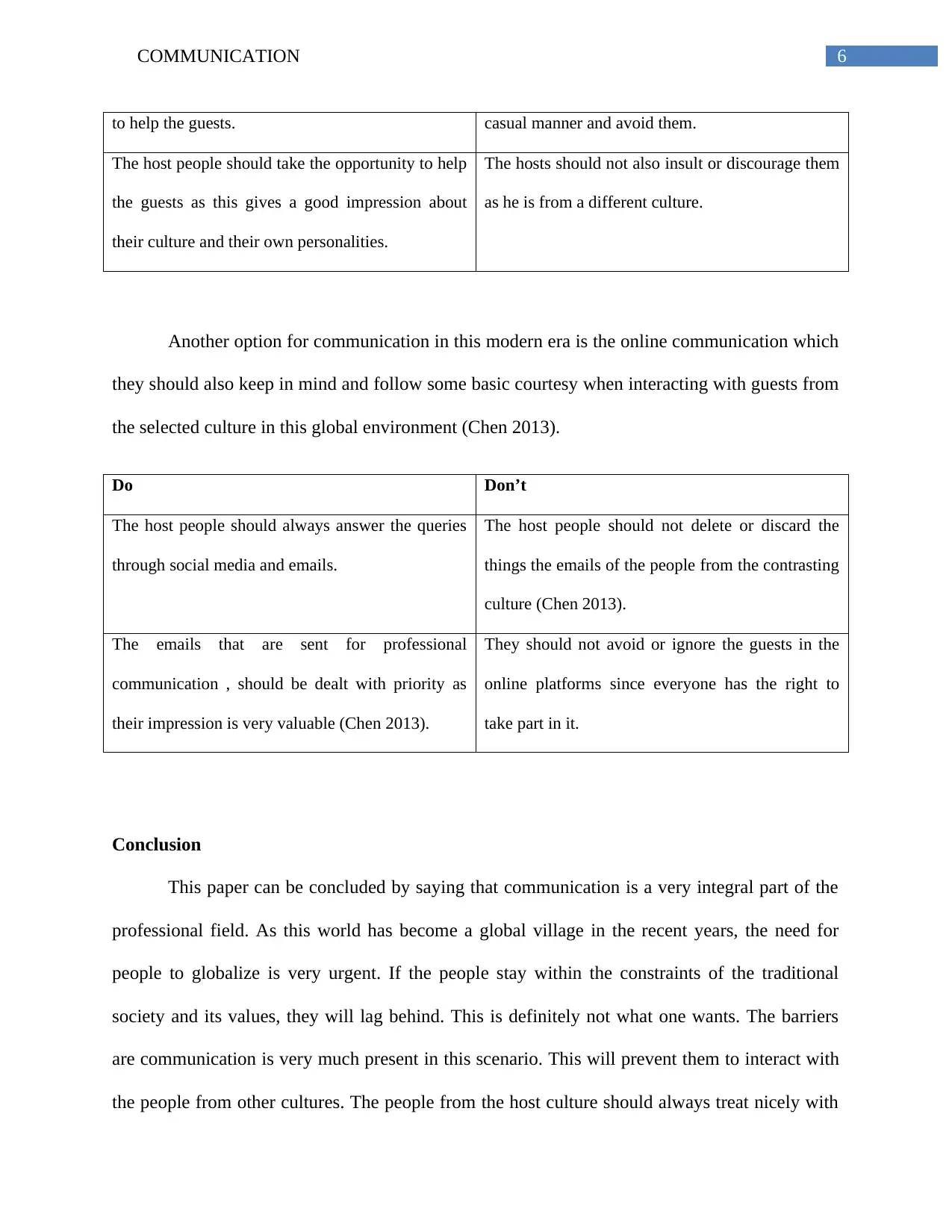
6COMMUNICATION
to help the guests. casual manner and avoid them.
The host people should take the opportunity to help
the guests as this gives a good impression about
their culture and their own personalities.
The hosts should not also insult or discourage them
as he is from a different culture.
Another option for communication in this modern era is the online communication which
they should also keep in mind and follow some basic courtesy when interacting with guests from
the selected culture in this global environment (Chen 2013).
Do Don’t
The host people should always answer the queries
through social media and emails.
The host people should not delete or discard the
things the emails of the people from the contrasting
culture (Chen 2013).
The emails that are sent for professional
communication , should be dealt with priority as
their impression is very valuable (Chen 2013).
They should not avoid or ignore the guests in the
online platforms since everyone has the right to
take part in it.
Conclusion
This paper can be concluded by saying that communication is a very integral part of the
professional field. As this world has become a global village in the recent years, the need for
people to globalize is very urgent. If the people stay within the constraints of the traditional
society and its values, they will lag behind. This is definitely not what one wants. The barriers
are communication is very much present in this scenario. This will prevent them to interact with
the people from other cultures. The people from the host culture should always treat nicely with
to help the guests. casual manner and avoid them.
The host people should take the opportunity to help
the guests as this gives a good impression about
their culture and their own personalities.
The hosts should not also insult or discourage them
as he is from a different culture.
Another option for communication in this modern era is the online communication which
they should also keep in mind and follow some basic courtesy when interacting with guests from
the selected culture in this global environment (Chen 2013).
Do Don’t
The host people should always answer the queries
through social media and emails.
The host people should not delete or discard the
things the emails of the people from the contrasting
culture (Chen 2013).
The emails that are sent for professional
communication , should be dealt with priority as
their impression is very valuable (Chen 2013).
They should not avoid or ignore the guests in the
online platforms since everyone has the right to
take part in it.
Conclusion
This paper can be concluded by saying that communication is a very integral part of the
professional field. As this world has become a global village in the recent years, the need for
people to globalize is very urgent. If the people stay within the constraints of the traditional
society and its values, they will lag behind. This is definitely not what one wants. The barriers
are communication is very much present in this scenario. This will prevent them to interact with
the people from other cultures. The people from the host culture should always treat nicely with
Paraphrase This Document
Need a fresh take? Get an instant paraphrase of this document with our AI Paraphraser

7COMMUNICATION
the people from the guest culture. This will help to create a better working environment and
cultural balance.
the people from the guest culture. This will help to create a better working environment and
cultural balance.
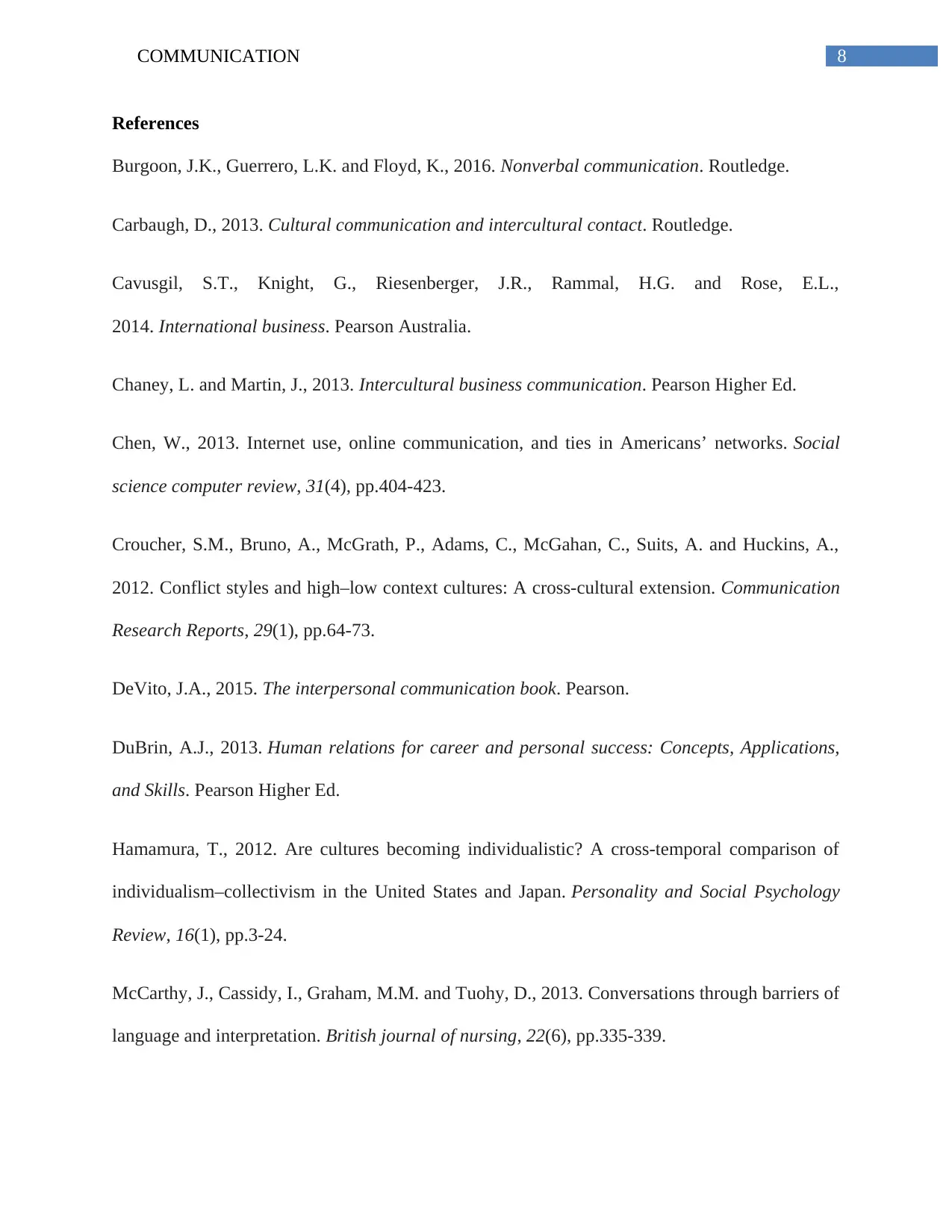
8COMMUNICATION
References
Burgoon, J.K., Guerrero, L.K. and Floyd, K., 2016. Nonverbal communication. Routledge.
Carbaugh, D., 2013. Cultural communication and intercultural contact. Routledge.
Cavusgil, S.T., Knight, G., Riesenberger, J.R., Rammal, H.G. and Rose, E.L.,
2014. International business. Pearson Australia.
Chaney, L. and Martin, J., 2013. Intercultural business communication. Pearson Higher Ed.
Chen, W., 2013. Internet use, online communication, and ties in Americans’ networks. Social
science computer review, 31(4), pp.404-423.
Croucher, S.M., Bruno, A., McGrath, P., Adams, C., McGahan, C., Suits, A. and Huckins, A.,
2012. Conflict styles and high–low context cultures: A cross-cultural extension. Communication
Research Reports, 29(1), pp.64-73.
DeVito, J.A., 2015. The interpersonal communication book. Pearson.
DuBrin, A.J., 2013. Human relations for career and personal success: Concepts, Applications,
and Skills. Pearson Higher Ed.
Hamamura, T., 2012. Are cultures becoming individualistic? A cross-temporal comparison of
individualism–collectivism in the United States and Japan. Personality and Social Psychology
Review, 16(1), pp.3-24.
McCarthy, J., Cassidy, I., Graham, M.M. and Tuohy, D., 2013. Conversations through barriers of
language and interpretation. British journal of nursing, 22(6), pp.335-339.
References
Burgoon, J.K., Guerrero, L.K. and Floyd, K., 2016. Nonverbal communication. Routledge.
Carbaugh, D., 2013. Cultural communication and intercultural contact. Routledge.
Cavusgil, S.T., Knight, G., Riesenberger, J.R., Rammal, H.G. and Rose, E.L.,
2014. International business. Pearson Australia.
Chaney, L. and Martin, J., 2013. Intercultural business communication. Pearson Higher Ed.
Chen, W., 2013. Internet use, online communication, and ties in Americans’ networks. Social
science computer review, 31(4), pp.404-423.
Croucher, S.M., Bruno, A., McGrath, P., Adams, C., McGahan, C., Suits, A. and Huckins, A.,
2012. Conflict styles and high–low context cultures: A cross-cultural extension. Communication
Research Reports, 29(1), pp.64-73.
DeVito, J.A., 2015. The interpersonal communication book. Pearson.
DuBrin, A.J., 2013. Human relations for career and personal success: Concepts, Applications,
and Skills. Pearson Higher Ed.
Hamamura, T., 2012. Are cultures becoming individualistic? A cross-temporal comparison of
individualism–collectivism in the United States and Japan. Personality and Social Psychology
Review, 16(1), pp.3-24.
McCarthy, J., Cassidy, I., Graham, M.M. and Tuohy, D., 2013. Conversations through barriers of
language and interpretation. British journal of nursing, 22(6), pp.335-339.
⊘ This is a preview!⊘
Do you want full access?
Subscribe today to unlock all pages.

Trusted by 1+ million students worldwide
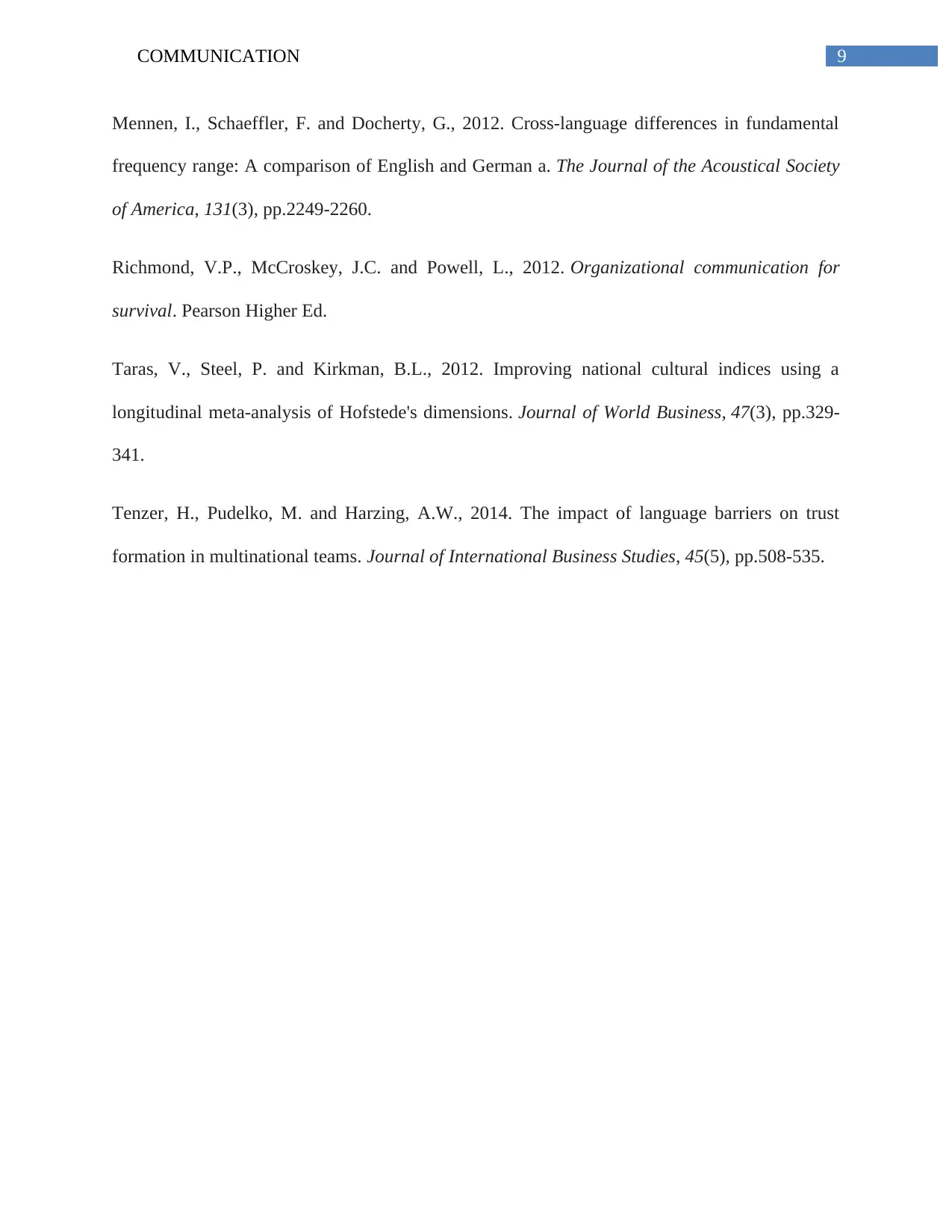
9COMMUNICATION
Mennen, I., Schaeffler, F. and Docherty, G., 2012. Cross-language differences in fundamental
frequency range: A comparison of English and German a. The Journal of the Acoustical Society
of America, 131(3), pp.2249-2260.
Richmond, V.P., McCroskey, J.C. and Powell, L., 2012. Organizational communication for
survival. Pearson Higher Ed.
Taras, V., Steel, P. and Kirkman, B.L., 2012. Improving national cultural indices using a
longitudinal meta-analysis of Hofstede's dimensions. Journal of World Business, 47(3), pp.329-
341.
Tenzer, H., Pudelko, M. and Harzing, A.W., 2014. The impact of language barriers on trust
formation in multinational teams. Journal of International Business Studies, 45(5), pp.508-535.
Mennen, I., Schaeffler, F. and Docherty, G., 2012. Cross-language differences in fundamental
frequency range: A comparison of English and German a. The Journal of the Acoustical Society
of America, 131(3), pp.2249-2260.
Richmond, V.P., McCroskey, J.C. and Powell, L., 2012. Organizational communication for
survival. Pearson Higher Ed.
Taras, V., Steel, P. and Kirkman, B.L., 2012. Improving national cultural indices using a
longitudinal meta-analysis of Hofstede's dimensions. Journal of World Business, 47(3), pp.329-
341.
Tenzer, H., Pudelko, M. and Harzing, A.W., 2014. The impact of language barriers on trust
formation in multinational teams. Journal of International Business Studies, 45(5), pp.508-535.
1 out of 10
Related Documents
Your All-in-One AI-Powered Toolkit for Academic Success.
+13062052269
info@desklib.com
Available 24*7 on WhatsApp / Email
![[object Object]](/_next/static/media/star-bottom.7253800d.svg)
Unlock your academic potential
Copyright © 2020–2025 A2Z Services. All Rights Reserved. Developed and managed by ZUCOL.





